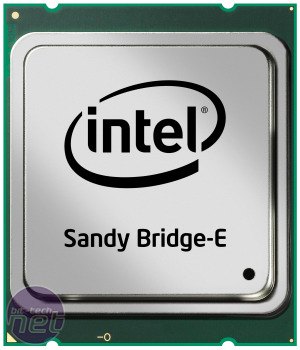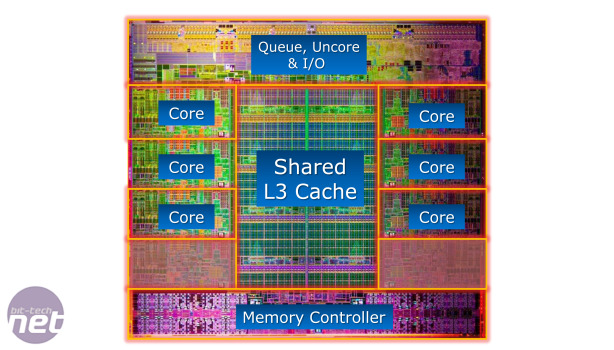Intel Sandy Bridge E Review
Manufacturer: IntelUK price (as reviewed): From £479 to £839 inc VAT
US price (as reviewed): From $555 to $990 ex tax
There’s been plenty of rumour and speculation surrounding Sandy Bridge E since we first heard about the new CPU series back in April 2010. Initially we were under the impression that the 'E' stood for 'Enthusiast' or 'Extreme', even though Intel denied the later at IDF earlier this year. Regardless, having tested several Sandy Bridge E CPUs over the last few months we're not convinced that either moniker is correct, as we'll explain.
If you only glanced at the specs of Sandy Bridge E you could be easily forgiven for dismissing it as merely an existing LGA1155 Sandy Bridge CPU that has had two extra cores bolted on plus a more sophisticated memory controller.
However, that wouldn't really be a fair assessment. This is because, like AMD recently did with its woeful FX-8150, Intel has taken a workstation/server CPU, and repurposed it as a high-end desktop CPU. That 8-core (16-thread) workstation/server CPU, codenamed Romley was first announced at IDF last year.
However, it's yet to be released, as its development has hit a number of snags over the last few months. That hasn't stopped Intel from stripping down Romley and releasing it as Sandy Bridge E.
So what differentiates a Sandy Bridge E processor from a Sandy Bridge CPU? The most obvious difference is the addition of two extra physical cores, bringing the total up to six. As each physical core also sports a secondary logical core thanks to Hyper-Threading, this means that a Sandy Bridge E CPU can process up to 12 twelve threads simultaneously.
While each physical core in a Sandy Bridge E CPU has the same amount of Level 1 and Level 2 cache as a Sandy Bridge processor, there's up to 15MB of Level 3 cache in a Sandy Bridge E processor rather than the 8MB in the Sandy Bridge design. This means that Sandy Bridge E processors have up to 2.5MB of Level 3 cache per core versus 2MB per core of Sandy Bridge. However, as we'll see, not all Sandy Bridge E CPUs have the same amount of Level 3 cache, so check carefully when speccing up a new system.
You can trace the Romley ancestry of Sandy Bridge E in
this die shot, which clearly shows the two 'missing' cores.
this die shot, which clearly shows the two 'missing' cores.
To feed all those extra cores, Intel has developed a new memory controller, which is capable of addressing four channels at once. This means you're supposed to install DIMMs in multiples of four for best performance. However, while this in theory provides double the memory bandwidth to the system over Sandy Bridge's dual-channel memory controller, it has grave consequences for motherboard design (more on this later).
The other significant difference between Sandy Bridge E and its Sandy Bridge forebear is that the new 6-core variant lacks the on-die Processor Graphics. This is emminently sensible as the power users that Sandy Bridge E is targetted at are extremely unlikely to use an underpowered on-board GPU. Even so, Sandy Bridge E retains a variant of the ring bus technology of Sandy Bridge, the central bus that links the various units within the CPU togther (i.e. cores, cache, I/O and memory controllers). As such, contrary to the hope of many enthusiasts, Sandy Bridge E doesn't see the return of a massively overclockable bus (more on this later).
Thanks to the extra cores and more complex memory controller, Sandy Bridge E CPUs require many more connections to the motherboard than the 1,155 connections of Sandy Bridge's LGA1155 CPU socket. Instead, Sandy Bridge E CPUs are built into a new far-larger LGA2011 package. This means you'll need to buy a new motherboard if you want to upgrade to Sandy Bridge E.
Intel has announced three Sandy Bridge E processors, although only two will be available to buy at launch. The odd one out, the Core i7-3820, isn't due until early next year. The table below summarises the principle differences between the three Sandy Bridge E chips.
| Intel Sandy Bridge E processors | |||||||
| Name | Nominal Frequency | Max Turbo Boost Frequency | TDP | Physical Cores | Level 2 cache | Level 3 cache | SRP |
| *Core i7-3960X Extreme Edition | 3.33GHz | 3.9GHz | 130W | 6 | 6 x 256KB | 15MB | $990 |
| *Core i7-3930K | 3.2GHz | 3.8GHz | 130W | 6 | 6 x 256KB | 12MB | $555 |
| Core i7-3820 | 3.6GHz | 3.9GHz | 130W | 4 | 4 x 256KB | 10MB | Unknown |
| * = Launch models |
As you can see, the two Sandy Bridge E CPUs that are launching today are clocked at a modest 3.3GHz (the Core i7-3960X Extreme Edition) and 3.2GHz (the Core i7-3930K). However, both support Turbo Boost, so can dynamically overclock themselves up to 3.9GHz and 3.8GHz respectively, depending on the CPU load, power draw and the CPU and VRM temperature.
Finally, before we dive into the CPU reviews themselves its worth pointing out unlike other retail boxed CPUs, Sandy Bridge E chips don't include a cooler as standard. Instead, you'll need to go out and buy your own LGA2011-compatible cooler. Due to the significantly higher TDP of Sandy Bridge E (130W versus 95W) and larger socket, many coolers cannot cope with Sandy Bridge E processors.
Equally, while some LGA1366 coolers physically fit onto LGA2011 motherboards, they may not provide enough clip pressure to ensure sufficient contact between the pins in the processor socket and the pads on the bottom of the CPU, potentially killing the CPU and motherboard.

MSI MPG Velox 100R Chassis Review
October 14 2021 | 15:04











Want to comment? Please log in.